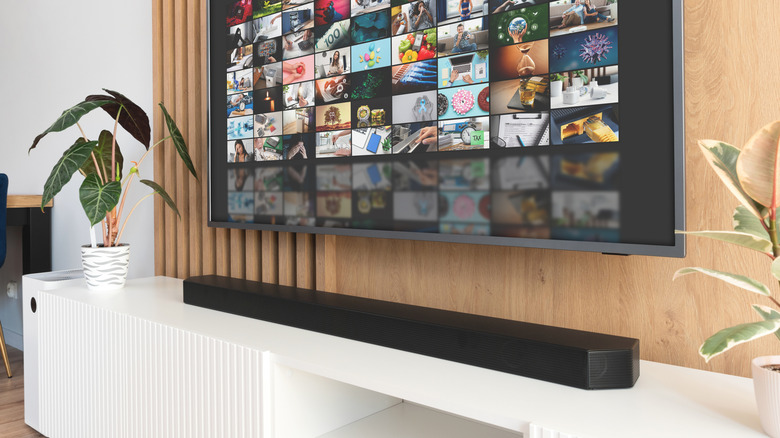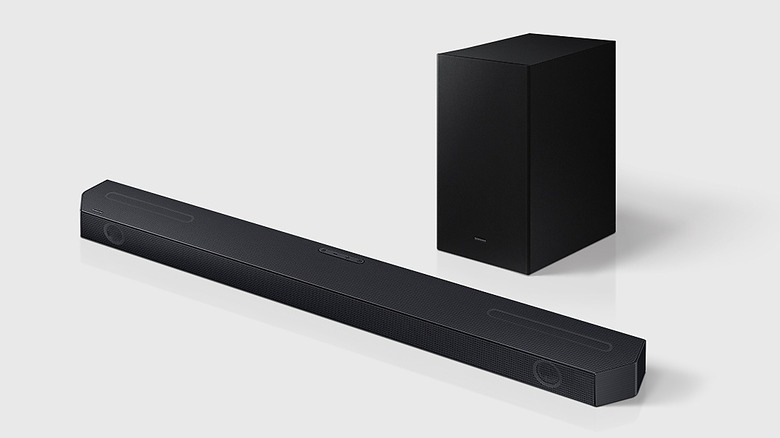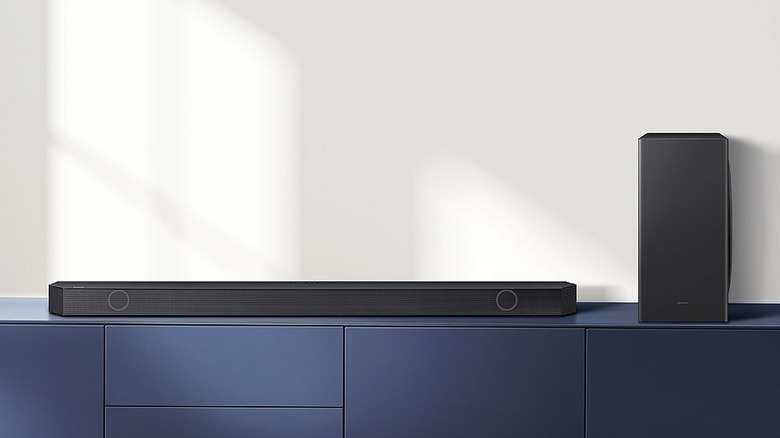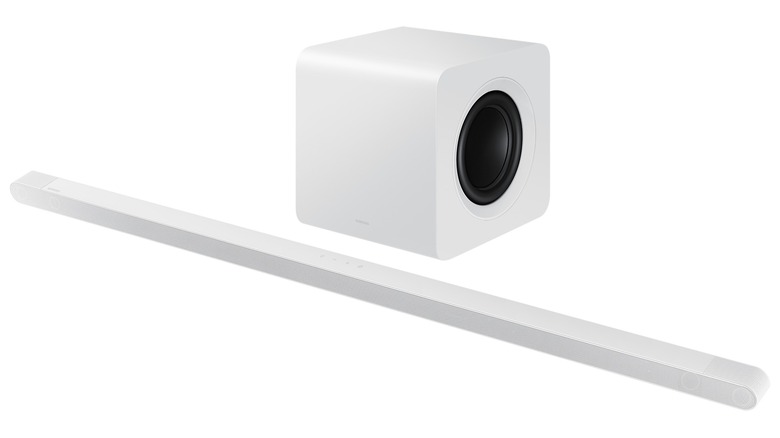12 Of The Best Soundbars You Can Buy In 2024 (Ranked By Consumer Reports)
Television display technology has developed by leaps and bounds over the past decade or so, with technologies like Mini LED and OLED bringing new levels of visual quality to the home viewing experience. But one aspect of the TV experience has remained broadly the same (or even gotten worse): the speakers.
It's not hard to see why, either: Slim TVs necessitate tiny speakers, while the lack of bezels also means that built-in speakers have to fire rearward or downward instead of directly at the viewer. They're fine in a pinch, but anyone who wants great audio quality will find built-in TV speakers woefully inadequate.
The solution for many is soundbars. The best ones on the market offer great sound quality and surround sound capabilities, with some even capable of presenting genuine surround sound via rear satellite speakers. They're not always cheap, but investing in a good-quality soundbar is worth it for significantly better sound quality for TV and movies. To help you level up your movie-watching experience, we've compiled a list of the best soundbars you can buy, ranked according to Consumer Reports' ratings.
12. Samsung HW-Q600C
We kick off our list with a brand that you'll see multiple times here: Samsung. The HW-Q600C is the lowest-end Samsung soundbar on here, but that doesn't mean it's a slouch. The Samsung HW-Q600C offers 3.1.2-channel sound with support for Dolby Atmos and DTS:X out of the box — albeit without true surround sound, given the lack of rear speakers in the package. You can buy those separately, however.
As with many of Samsung's soundbars, the HW-Q600C has a handful of additional features that help it play nicely with TVs, especially Samsung products. Chief amongst those features is Q Symphony, which works with select Samsung TVs to synchronize the built-in speakers and soundbar for higher-quality sound. The HW-Q600C also automatically changes audio modes depending on the content, aiming to optimize the sound profile to suit what's on screen. Sadly, this relatively more affordable Samsung soundbar has little app connectivity, with Apple AirPlay, Google Chromecast, and Spotify Connect absent.
Consumer Reports gave the HW-Q600C a solid mid-range score, praising the balanced sound quality and decent bass. It's not the most hi-fi soundbar on the market, with slightly dull treble and constrained mid-range frequencies, but it seems a solid buy considering the price — especially if you're already rocking a Samsung TV.
11. Vizio Elevate P514a-H6
Up next is one of two Vizio soundbars that made it into the upper echelon of Consumer Reports' TV soundbars, the Elevate P514a-H6. Unlike the (admittedly more affordable) Samsung, the Vizio Elevate P514a-H6 is a proper surround system, with 5.1.4 channels of sound coming from the soundbar, subwoofer, and rear speakers.
As you might expect, the Elevate supports both Dolby Atmos and DTS:X, with Consumer Reports noting that it capably delivers the full 360-degree sound experience that these surround sound technologies are best known for. The Vizio's rotating speakers probably help here, automatically turning to point at the ceiling in surround sound modes and adding that crucial vertical dimension to the sound when needed, without giving up the benefits of straight-ahead orientation when playing non-surround content.
Sound quality is decent, too. Bass is a bit boomy, but the treble extension is good — if perhaps a bit sharp, with reasonably balanced mid-range frequencies. The P514a-H6 gets a solid score from Consumer Reports, indicating it should be a decent step up from the Samsung HW-Q600C. However, Consumer Reports wasn't keen on the Elevate's ease of use, scoring it on the lower end of the range in that particular category, unfortunately without clarifying why.
10. Vizio Elevate M512e-K6
The Vizio Elevate M512e-K6 manages to edge ahead of its sibling despite a reduction in channel count. The M512e-K6, as you may have been able to guess from the name, is a 5.1.2-channel system consisting of a soundbar, two low-profile surround speakers, and a subwoofer, with the requisite Dolby Atmos and DTS:X support present and fully accounted for, thanks to the extra satellite speakers.
Consumer Reports gave the M512e-K6 the same score as the P514a-H6, as well as high ratings in the sound quality department. As with the other Vizio soundbar, the site found that the bass and treble were the best aspects of the sound, although it did feel that the former was a bit boomy and the latter perhaps slightly sharp. Surround sound works as expected, with the M512e-K6 capable of covering a medium-sized room — even with two fewer overhead channels than the Elevate P514a-H6.
Another difference between the two Vizio models is in the low-frequency extension: The M512e-K6 only goes down to 45 Hz, while the P514a-H6 goes as low as 30 Hz. Is it a massive downgrade? Probably not, but it is something to consider if you want the most rumble possible from your subwoofer.
9. Sonos Beam (Gen 2)
Now comes the first appearance of one of the few brands capable of truly going toe-to-toe with Samsung in the soundbar stakes — at least, according to Consumer Reports. Say hello to the second-generation Sonos Beam, the company's mid-range soundbar offering. The Beam is a five-channel soundbar without a dedicated subwoofer or rear speakers, one of the few such models on this list.
The Beam supports Dolby Atmos with virtual surround sound and also supports several high-resolution audio formats — including Dolby Atmos Music — which you can send to the soundbar via the Sonos App. You can also pair your Sonos Beam to your iPhone and send audio via Apple AirPlay 2. IOS device owners get a bonus feature called Trueplay, which uses iOS device speakers to analyze your room's acoustics and tune the sound output to fit your room.
The Beam Gen 2 faired well — and got a Smart Buy award — in Consumer Reports' testing, with the site praising the unit's ease of use. It sounds good, too, although the lack of a dedicated subwoofer predictably limits the Beam's bass response. That said, what bass is there seems to be quite detailed, while the treble is also capable, even if it doesn't quite extend to the highest frequencies.
8. Samsung HW-Q800C
We're firmly at the upper end of the list now, with an older — but still very capable — soundbar from Samsung, the Samsung HW-Q800C. The Q800C is a 5.1.2-channel system with a soundbar and dedicated subwoofer, but no rear speakers. As with all of Samsung's higher-end soundbars, the HW-Q800C is Dolby Atmos and DTS:X-capable, with the soundbar's vertical- and side-firing speakers doing a good job of presenting the surround sound image.
The HW-Q800C has the same Q Symphony feature as the cheaper HW-Q600C but introduces a feature that Samsung calls SpaceFit Sound Pro into the mix. SpaceFit Sound Pro, when used with a compatible TV, allows the soundbar to adjust the sound output for your living room or home theater space. It's a shame this is a Samsung-only feature, but those of you who've invested in one of the company's highly rated TVs should try it out and see if it helps.
Consumer Reports gave the HW-Q800C solid scores in sub-categories such as sound quality and overall versatility, where the Q800C got a top score. The sound quality seems good overall, although it has the same issues as the cheaper Q600C, in that the bass is a bit strong and the treble not quite as sharp and clear as other soundbars.
7. Samsung HW-S801B/ZA
Samsung's HW-S801B/ZA takes a slightly different path than the Q-series models we've looked at thus far. Not necessarily in terms of the features, mind you: Q Symphony, SpaceFit Sound Pro, and surround sound (Dolby Atmos and DTS:X) are all still present. Instead, the HW-S801B/ZA tries to be even more unobtrusive than the Q-series soundbars, with white finishes and a low-profile main soundbar that Samsung likely hopes will blend into even more living rooms than its other offerings.
The 3.1.2-channel HW-S801B/ZA's soundbar measures just 1.5 inches tall and 1.6 inches deep, but the reduced dimensions seem to have affected sonic performance much according to Consumer Reports, with balanced delivery that retains the strengths and weaknesses of other Samsung soundbars thus far — overly emphasized bass and reduced treble extension are the primary drawbacks. There's also apparently a slight dip in the lower midrange, which isn't an issue on other Samsung soundbars.
Consumer Reports also felt that the UI was slightly unintuitive, leaving the Samsung with a mid-tier score for the unit's ease of use. That didn't stop the Samsung HW-S801B/ZA from earning an overall respectable rating, though, allowing it to just sneak past the HW-Q800C on this list.
6. Sonos Arc
One step up from the Sonos Beam is the Sonos Arc, a larger 5.0.2-channel soundbar boasting 11 speakers, Dolby Atmos support, and the ability to pair with Sonos' wireless speakers and subwoofers for a full-on surround sound setup for those who want to take things up a notch. The Arc has all the core features of the cheaper Sonos Beam, so you get Trueplay sound tuning (with an iOS device), Sonos app connectivity, Dolby Atmos music, touch controls, and voice assistant — Google Assistant and Amazon Alexa — support.
Night Sound and Speech Enhancement are also here. The former reduces audio dynamic range for nighttime viewing, while the latter boosts voice frequencies for clearer dialogue. Owners of the well-received Sonos Ace headphones will also be pleased to know that the Arc, like the Beam and Arc Ultra, supports TV Audio Swap for quickly switching between the soundbar and the headphones. The main upgrade over the Beam is the extra channels, with two up-firing speakers on the Arc. Consumer Reports praised the Arc's 5.1 and Atmos capabilities, with the soundbar more capable of presenting vertical and overhead sounds than the Beam.
Consumer Reports also enjoyed the Arc's overall sound quality, even if it wasn't quite perfect thanks to slightly prominent bass and reduced treble intensity, putting the model just outside the top soundbars Consumer Reports has reviewed as of December 2024.
5. LG SC9S
LG may make some of the best 50- to 55-inch OLED TVs available, but the Korean giant has thus far been severely underrepresented on this list, unlike its rival Samsung. And while LG can't really compete at the top end against that rival, the LG SC9S soundbar at least helps ensure that it's not a complete blowout for Samsung here.
The SC9S is LG's top-of-the-line soundbar, boasting a 3.1.3-channel, non-surround setup from the soundbar, with a triple-speaker setup for the up-firing units and a dedicated subwoofer for the bass frequencies. Consumer Reports broadly liked the speaker's sound, although the site did point out a slightly reverberant quality to the midrange that didn't quite work in its favor. It didn't ruin the LG, though, which also handles surround sound content as well as you might expect for a system without rear speakers.
LG loads the SC9S with a range of software enhancements: Triple Level Spatial Sound, a 3D sound engine; AI Room Calibration to automatically correct the sound to suit your space; and AI Sound Pro, a feature that automatically changes sound modes according to content. The LG SC9S can also work with select LG TVs to synchronize sound output between the soundbar and built-in speakers. The SC9S is one of the two products on this list to earn Consumer Reports' Smart Buy award.
4. Samsung HW-S801D
If you like the look of Samsung's HW-S801B/ZA but want to take advantage of your TV's HDMI eARC connectivity, the Samsung HW-S801D might just be the perfect fit. It retains all of the S801B/ZA's strengths, such as its clean white finish and more svelte soundbar, but with the extra bandwidth of eARC and all the potential quality benefits it could offer.
Beyond the eARC support, the HW-S801D is broadly similar to the HW-S801B/ZA, right down to the Consumer Reports scores. The S801D and the S801B/ZA have nearly identical scores and features aside from eARC, with Q Symphony, SpaceFit Sound Pro, and app connectivity — Apple, Google, Spotify, and Roon — all available to use. The measurements are essentially identical, too, so you're not giving anything up in exchange for the S801D's eARC — just a higher price.
Consumer Reports' review reads nearly identically, too, with punchy but somewhat over-emphasized bass, even but slightly grainy treble, and somewhat laid-back treble. Much of a muchness compared to the cheaper unit, then — so, unless you need eARC, you may be better off saving a bit of money and opting for the S801B/ZA.
3. Sonos Arc Ultra
One of the top soundbars according to Consumer Reports is Sonos' flagship offering, the Sonos Arc Ultra. This premium soundbar — expect to pay $999 or so — is a big upgrade over Sonos' more affordable offerings in terms of channel configuration. How big? The Arc Ultra boasts a 9.1.4-channel setup and some fancy speaker tech to offer a sonic experience that's a cut above its siblings — earning it a SlashGear Editor's Choice award when we reviewed it in November.
That fancy tech comes in the form of what Sonos calls Sound Motion, which adds motors to the woofers to deliver much more bass than you might expect from something compact. Our Chris Davies liked the Arc Ultra's bass output, but Consumer Reports found it a bit too bassy — your mileage will undoubtedly vary. Consumer Reports also found that the midrange was a bit dark, possibly due to some bleed from the bass woofers, while the treble is again not quite as sharp as the site would have liked.
The Arc Ultra has all the features and connectivity of its cheaper siblings but with one notable bonus: Speech Enhancement has three levels on the Arc Ultra, unlike the simple on/off toggle on the lower-end Sonos soundbars. Beyond that, everything else is as you'd expect if you're familiar with any of Sonos' other soundbars. Consumer Reports gave the Arc Ultra a respectable score.
2. Samsung HW-Q800D
There's only one brand that can trump Sonos in the soundbar races as far as Consumer Reports is concerned, and that's Samsung. The brand's HW-Q800D subwoofer comes in near the top in Consumer Reports' rankings with a higher-end score from its soundbar-and-subwoofer 5.1.2 combo.
If you've read the other Samsung soundbar overviews, you'll likely not find anything to surprise you here. Q Symphony helps synchronize the sound from your Samsung TV's built-in speakers to the soundbar, SpaceFit Sound Pro intelligently adapts the soundbar's sonic output to suit your viewing space, and the usual app connectivity and wireless Dolby Atmos is on hand so you can feed any content you want to the Samsung HW-Q800D.
The similarities to Samsung's other offerings extend to the sound itself, too. Consumer Reports found that the HW-Q800D had good but perhaps overpowering bass (depending on the content) and a balanced but slightly messy midrange. Treble frequencies were decent but slightly recessed, broadly in line with Samsung's other premium soundbars. Surround sound performance was what you'd expect from a soundbar-and-sub setup, with good vertical extension but a lack of rear spatial cues.
1. Samsung HW-Q930C
Samsung completes a one-two finish on our list with the Samsung HW-Q930C, the top soundbar currently in the Consumer Reports database. The Q930C has the most channels of the Samsung soundbar setups here, with 9.1.4-channel sound from its combination of main soundbar, wireless subwoofer, and rear speakers.
Tech-wise, the Q930C is not much different from Samsung's more affordable 800-series soundbars. Features like Q Symphony and SpaceFit Sound Pro are present, as are Alexa functionality and app connectivity in the form of Apple AirPlay, Google Chromecast, and Spotify Connect. Wireless Dolby Atmos support is also available.
Consumer Reports enjoyed the Q930C's sound quality, although it's not perfect. It praised the Q930C's bass extension but pointed out that the bass sounded a bit dull, while the mids had a slightly fake quality to them. The treble extends well, like the bass, although it does come at the cost of being somewhat fizzy. Surround sound performance is as good as you'd expect from a 9.1.4 setup, filling up the room and presenting spatial cues realistically from all directions thanks to the rear speakers.
Our methodology
Ranking and rating audio equipment is often deeply subjective, with listener preferences playing a huge role in perceived quality. So, rather than impart our own subjectivities onto the topic, we've gone with Consumer Reports' rankings of the soundbars it's reviewed. The 12 products on this list are among the top soundbars in Consumer Reports' database, sorted by the overall review score.
Consumer Reports takes into account several tests, from general — sound quality and versatility — to more specific evaluations such as the soundbars' Wi-Fi audio streaming capabilities, surround sound prowess, and digital voice assistant features.
To be clear, Consumer Reports isn't the only valid source of soundbar reviews, but its longevity and great track record means that it's we think it's as good a source as any — but do check out other outlets' opinions before spending your money.













